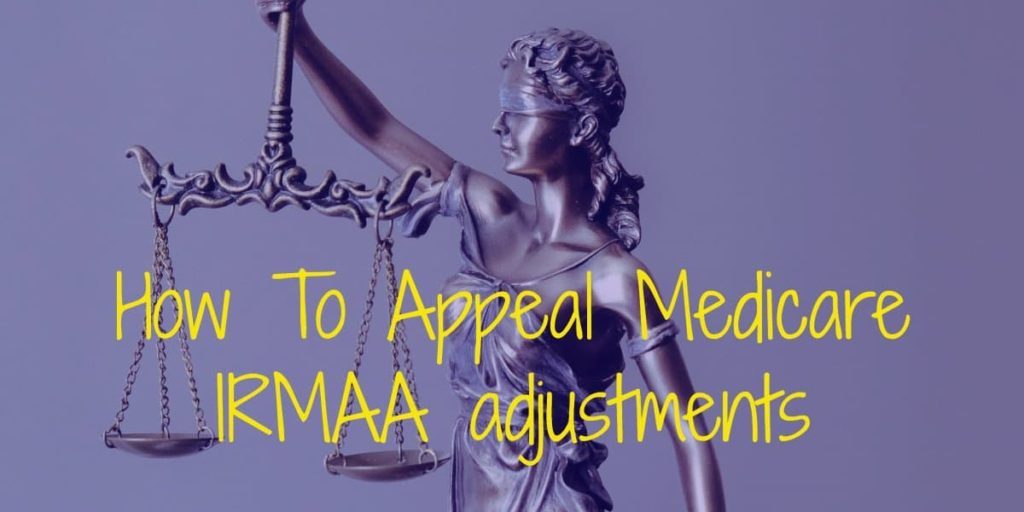Everything You Need to Know About the IRMAA Brackets and the Appeal Opportunities
The Income-Related Monthly Adjustment Amount (IRMAA) can significantly influence Medicare premiums for people and pairs with higher incomes. Understanding the IRMAA braces is vital for recipients that might not understand how their customized adjusted gross earnings influences costs. Additionally, there are avenues for appealing IRMAA decisions, especially in instances of revenue changes. Discovering the nuances of IRMAA can disclose essential approaches that may help handle these expenses properly.
Comprehending IRMAA: What It Is and Just how It Functions
Although numerous individuals may not know it, the Income-Related Monthly Adjustment Amount (IRMAA) plays a considerable duty in determining Medicare costs for higher-income recipients. Particularly, IRMAA is a surcharge that affects those with modified adjusted gross earnings above certain limits. This modification makes sure that people who gain more add a larger share towards their Medicare insurance coverage.
The Social Security Administration calculates IRMAA based on tax obligation return information from 2 years prior, which implies existing premium modifications might reflect previous income levels. Beneficiaries are notified of their IRMAA status through a letter, outlining any additional premium amounts owed. Comprehending IRMAA is crucial for beneficiaries, as it straight influences their month-to-month health care prices. This knowledge outfits them to make informed choices about their monetary planning related to Medicare, ensuring they are gotten ready for prospective premium increases based upon earnings modifications.
The IRMAA Brackets Described
The IRMAA braces classify beneficiaries based on their modified adjusted gross revenue, identifying the additional premium quantities they have to pay for Medicare protection (irmaa appeal). These braces are structured right into rates, with each tier equivalent to particular earnings arrays. As a recipient's revenue rises, so does their IRMAA additional charge, which can considerably influence their general health care expenses
Individuals with incomes below a certain limit face no added costs, while those in greater braces may experience surcharges that increase incrementally. This modern structure aims to line up costs contributions with receivers' economic capacities, guaranteeing that those with better means add even more in the direction of their health care.
The IRMAA braces are reviewed every year, mirroring adjustments in revenue degrees and changes for inflation. Comprehending these braces is crucial for beneficiaries to expect possible prices and plan their medical care budget plans efficiently, ultimately helping in economic decision-making pertaining to Medicare coverage.
Variables That Influence Your IRMAA Premium Adjustments
Numerous factors can affect modifications to an individual's IRMAA costs, which are largely based upon their customized adjusted gross earnings. This income includes salaries, returns, capital gains, interest, and various other gross income sources. Modifications in revenue can develop from various conditions, such as retirement, job loss, or inheritance, which may bring about a reassessment of IRMAA costs.
Additionally, tax obligation filing condition plays a significant function. People submitting jointly may have various costs ramifications than those filing independently. Various other factors, such as life events like marital relationship or divorce, can also affect revenue degrees and, as a result, IRMAA adjustments.
The Social Protection Management evaluates revenue from two years prior to determine existing costs, stressing the significance of consistent economic tracking. Understanding these aspects is essential for individuals as they browse potential modifications in their healthcare prices connected with Medicare.
How to Establish Your IRMAA Status
Determining one's IRMAA status requires an understanding of numerous vital variables, including earnings thresholds, submitting condition, and previous year earnings. Each of these elements can considerably impact the estimation of Medicare premiums. By analyzing these components, individuals can much better analyze their possible IRMAA responsibilities.
Earnings Thresholds Overview
Recognizing revenue limits is important for individuals navigating the complexities of IRMAA (Revenue Associated Monthly Adjustment Amount) These thresholds determine the added quantities individuals spend for Medicare Component B and Part D based on their modified adjusted gross income (MAGI) The thresholds can alter each year, so it is important to remain updated. For 2023, individuals with a MAGI over $97,000 and couples submitting jointly above $194,000 may face boosted costs. The limits are fractional into brackets, with greater earnings levels causing progressively greater adjustments. By properly analyzing their MAGI, people can ascertain their IRMAA standing and prepare for possible costs increases. Comprehending these revenue restrictions is crucial for effective financial planning pertaining to Medicare advantages.
Filing Condition Impact
While evaluating IRMAA condition, an individual's declaring standing plays a considerable duty in identifying costs adjustments for Medicare. The Irs acknowledges numerous filing conditions, consisting of single, wedded declaring jointly, wedded filing individually, and head of family. Each status has unique earnings limits that affect the IRMAA brackets. For circumstances, wedded couples filing jointly have a greater combined revenue limitation compared to single filers, which might influence their IRMAA commitments. On the other hand, those submitting independently encounter lower limits, potentially resulting in greater premiums. Understanding just how declaring status interacts with revenue levels is crucial for recipients to accurately assess their IRMAA effects and economic responsibilities concerning Medicare premiums. This understanding can aid in economic planning and prospective charms.
Previous Year Income
To assess IRMAA condition properly, individuals must consider their modified adjusted gross earnings (MAGI) from the previous tax year. This figure is important in establishing the IRMAA braces, which determine the extra premiums for Medicare. The Social Safety and security Administration calculates MAGI by taking the modified gross income and adding certain reductions, such as tax-exempt rate of interest. Consequently, individuals need my website to assess their tax obligation returns carefully to identify any kind of changes in earnings that can impact their IRMAA classification. Appealing the IRMAA resolution is possible by sending documentation showing the income change if one's revenue dramatically drops in the current year due to life adjustments. Recognizing exactly how previous year earnings affects IRMAA condition is vital for handling Medicare prices efficiently.
Actions to Appeal Your IRMAA Determination
People may discover themselves requiring to appeal their IRMAA determination because of adjustments in income or other qualifying scenarios. Comprehending qualification for charm is essential, as is acquainting oneself with the appeal submission procedure. These steps can aid make certain that people advocate properly for a reconsideration of their IRMAA standing.
Eligibility for Appeal

Appealing an IRMAA determination can be a vital action for those who believe their income has been improperly analyzed. To be qualified for a charm, individuals need to develop that their noted income does not show their existing financial scenario. This might consist of scenarios such as a considerable reduction in earnings, life-altering occasions like divorce, or the death of a partner. It is necessary for individuals to collect relevant documentation that confirms their cases, as this details will play an essential role in the allure procedure. Furthermore, individuals must submit their appeals within details time frames outlined by the Social Security Administration to make sure factor to consider. Recognizing these eligibility criteria is essential for a successful charm result.
Appeal Entry Process
Navigating the charm submission procedure for an IRMAA decision calls for mindful attention to information and adherence to certain steps. People must finish the proper appeal type given by the Social Safety Management (SSA) or its website. Next, it is essential to gather all pertinent paperwork that supports the allure, such as monetary statements or evidence of life adjustments impacting earnings. The finished type and sustaining papers must then be sent to the SSA within the marked timeframe, normally within 60 days of the resolution. After entry, candidates need to monitor their allure status and be prepared to react to any additional queries from the SSA. Recognizing these actions guarantees an extra reliable appeal procedure.
Common Reasons for IRMAA Appeals
While several individuals may discover themselves facing a raised Medicare costs due to the Income-Related Monthly Adjustment Amount (IRMAA), there are several typical premises for appealing these resolutions - irmaa appeal. One key factor for appeal is a significant decrease in earnings, which may take place due to retirement, work loss, or clinical expenses. Individuals may also appeal if their income was momentarily raised due to a single event, such as the sale of a property or a huge inheritance
Another usual reason is disparities in noted revenue, where people can provide documents to support their insurance claims. Additionally, people might appeal on the basis of changes in marital condition, which can impact documented revenue degrees. Recognizing these typical premises can assist people navigate the charm process properly and potentially minimize their Medicare costs. Each case is distinct, but these factors often offer as a structure for difficult IRMAA decisions.
Tips for Managing Your Medicare Expenses With IRMAA
Handling Medicare costs can be challenging, particularly for individuals impacted by the Income-Related Monthly Adjustment Amount (IRMAA) To efficiently manage these expenses, people ought to first analyze their present earnings and potential adjustments, such as retired life or reduced functioning hours, that might reduce their IRMAA bracket.

Additionally, people may profit visit here from consulting a monetary consultant or Medicare professional who can give personalized techniques for lowering general healthcare expenditures.
Lastly, staying informed concerning modifications in Medicare plans and tax legislations will encourage beneficiaries to make positive choices. By taking these steps, people can navigate the complexities of IRMAA and maximize their Medicare expenses effectively.
Frequently Asked Concerns
Exactly How Often Are IRMAA Brackets Adjusted or Updated?
IRMAA braces are usually readjusted every year, reflecting changes in earnings limits based upon rising cost of living and other economic aspects. This makes certain that the brackets remain relevant to current income levels and Medicare funding requirements.
Can IRMAA Affect My Qualification for Various Other Medicare Programs?
IRMAA can influence qualification for certain Medicare programs. Higher revenue modifications may result in increased premiums, potentially impacting enrollment decisions and economic assistance choices for beneficiaries looking for added coverage or additional strategies within Medicare.

What Occurs if I Miss the Appeal Due Date?
Missing the appeal deadline causes the rejection of the allure request. People may have to accept the original IRMAA determination, potentially leading to higher costs without option to contest the decision.
Are There Any Exceptions for Low-Income Individuals Concerning IRMAA?
There are no details exemptions for low-income individuals concerning IRMAA. However, you could try here individuals might certify for a reduction if they can demonstrate a considerable decline in earnings because of conditions like work loss or other economic hardships.
Just how Does My Income From Investments Effect My IRMAA Computation?
Financial investment income adds to the total customized adjusted gross earnings (MAGI) made use of in the IRMAA estimation. Higher investment revenue can bring about raised IRMAA repayments, affecting the general price of Medicare premiums for people.
Establishing one's IRMAA status calls for an understanding of several essential elements, including revenue thresholds, submitting status, and previous year earnings. Understanding earnings thresholds is crucial for individuals navigating the intricacies of IRMAA (Income Connected Monthly Adjustment Amount) If one's income dramatically drops in the current year due to life modifications, appealing the IRMAA resolution is possible by submitting paperwork demonstrating the revenue change. Individuals might discover themselves requiring to appeal their IRMAA determination due to adjustments in income or various other qualifying situations. Investment revenue contributes to the overall changed adjusted gross income (MAGI) made use of in the IRMAA calculation.